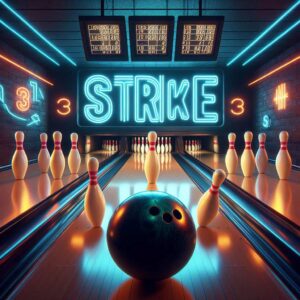Bowling is a fun and challenging sport enjoyed by millions worldwide. Whether you’re a casual bowler or a competitive league player, using the right bowling ball can make a huge difference in your performance. With so many different types of bowling balls available, it’s essential to understand the various options and how they can impact your game.
In this comprehensive guide, we’ll explore the different types of bowling balls based on their cover stock, core design, weight, and special features. We’ll also provide insights into choosing the right ball for your skill level, playing style, and lane conditions, ensuring you have the tools to succeed on the lanes.
Types of Bowling Balls Based on Cover Stock
The cover stock is the outer shell or surface of the bowling ball, and it plays a crucial role in determining the ball’s overall performance. There are three main types of cover stocks: plastic/polyester, urethane, and reactive resin.
-
Plastic/Polyester Bowling Balls
Plastic or polyester bowling balls are entry-level balls designed for beginners and straight shooters. They offer minimal traction on the lane, resulting in a smooth, straight roll with very little hooking action. These balls are ideal for those just starting out or for spare shooting situations where a straighter shot is desired.
While plastic balls lack the aggressiveness of other cover stocks, they are incredibly durable and require minimal maintenance. They are also the most affordable option, making them a popular choice for recreational bowlers or those on a budget.
-
Urethane Bowling Balls
Urethane bowling balls provide more friction and traction than plastic balls, offering better hooking potential. They sit between plastic and reactive resin balls in terms of performance, making them an excellent choice for intermediate bowlers looking to generate more hook without going to the extreme of a reactive resin ball.
Urethane balls are known for their predictability and controllability, as they don’t react as aggressively to changes in lane conditions as reactive resin balls. They’re also more durable and require less maintenance than reactive resin balls, making them a popular option for many league and tournament bowlers.
-
Reactive Resin Bowling Balls
Reactive resin bowling balls, also known as “particle” or “proactive” balls, are the most aggressive and high-performance cover stocks available. They are designed to create maximum friction and traction on the lane, resulting in a significant hooking action and backend motion.
Reactive resin balls can be further divided into three subcategories:
- Solid Reactive: These balls feature a solid reactive resin coverstock, providing a strong backend motion and continuous traction throughout the shot.
- Pearl Reactive: Pearl reactive balls have a semi-solid coverstock with a pearlized or polished appearance. They offer a smoother, more controlled motion compared to solid reactive balls.
- Hybrid Reactive: Hybrid reactive balls combine elements of solid and pearl reactive coverstocks, aiming to provide a balance between traction and control.
Reactive resin balls are typically recommended for advanced bowlers who can handle the aggressive motion and are skilled at adjusting to changing lane conditions. They require more maintenance and are generally more expensive than other cover stocks.
Types of Bowling Balls Based on Core Design
The core, or the inner component of a bowling ball, plays a crucial role in determining the ball’s overall motion and dynamics. There are three main types of cores: pancake/low RG cores, symmetrical cores, and asymmetric cores.
-
Pancake/Low RG Cores
Pancake or low RG (radius of gyration) cores are designed to promote more flare potential and backend motion. They have a lower RG value, which means the mass is concentrated closer to the core’s center, resulting in a more aggressive backend reaction and increased entry angle into the pocket.
Bowling balls with pancake cores are ideal for medium-dry to oily lane conditions, as they can help generate the necessary backend motion to strike consistently. However, they may be more challenging to control for beginners due to their aggressive nature.
-
Symmetrical Cores
Symmetrical cores are characterized by their uniform mass distribution, resulting in a consistent and predictable motion on the backend. These cores are designed to maintain a straight trajectory down the lane, with a gradual and controlled backend reaction.
Bowling balls with symmetrical cores are well-suited for a variety of lane conditions and can be an excellent choice for bowlers who prefer a more controlled and repeatable motion.
They are often recommended for intermediate to advanced bowlers who have developed a consistent release and can manage the ball’s trajectory effectively.
-
Asymmetric Cores
Asymmetric cores, also known as asymmetric weight blocks or asymmetric designs, feature an uneven mass distribution within the core. This asymmetry promotes an aggressive angular motion downlane, allowing the ball to create more traction and backend movement.
Bowling balls with asymmetric cores are particularly effective on heavy oil patterns or when more backend motion is desired. They can help generate a strong entry angle into the pocket, increasing strike potential. However, they may require more skill and experience to control, as their aggressive nature can lead to over/under reactions if not properly managed.
Types of Bowling Balls Based on Weight
Bowling balls are available in a range of weights, typically from 6 pounds to 16 pounds. The weight of the ball you choose can significantly impact your overall performance and playing experience.
Lighter Bowling Balls (6-10 lbs):
- Recommended for younger bowlers, those with physical limitations, or those seeking to reduce stress on their bodies.
- Lighter balls are easier to handle and can help improve rev rate and ball speed.
- However, they may lack the necessary momentum to consistently strike on heavier oil patterns.
Heavier Bowling Balls (11-16 lbs):
- Preferred by more experienced bowlers and those seeking maximum power and driving force.
- Heavier balls can create more pin-carrying potential and generate higher scoring opportunities.
- However, they require more physical strength and technique to control and may increase the risk of injury if not used properly.
Most adult bowlers typically use balls ranging from 14-16 pounds for maximum performance, while children and smaller adults may opt for lighter weights between 6-12 pounds.
It’s essential to choose a ball weight that feels comfortable and manageable for your physical abilities, while still providing the necessary momentum and strike potential.
Special Purpose Bowling Ball Types
In addition to the main categories based on cover stock, core design, and weight, there are several specialized types of bowling balls designed for specific purposes or situations.
-
Two-Piece Balls (Single Core)
Two-piece bowling balls consist of a single core covered by a single outer shell or cover stock. These balls are typically more affordable and offer a predictable and consistent motion, making them a popular choice for beginners and recreational bowlers.
-
Three-Piece Balls
Three-piece bowling balls feature a core surrounded by two separate outer layers: a high-density inner core and a separate outer cover stock. This construction allows for a more dynamic and aggressive motion, as the core and cover stock can interact differently based on their respective properties.
-
Particle/Composite Balls
Particle or composite bowling balls incorporate various materials or particles into their cover stock or core design. These particles can include glass, ceramic, or other additives that aim to enhance the ball’s overall performance or create unique motion characteristics.
-
Spare Balls
Spare balls are specialized bowling balls designed specifically for picking up spare shots. They typically feature a plastic or polyester cover stock and a straight, predictable motion, making them ideal for knocking down remaining pins after a strike or open frame.
Factors in Choosing the Right Bowling Ball
With so many different types of bowling balls available, selecting the right one can be a daunting task. Here are some key factors to consider when choosing a bowling ball:
-
Skill Level
Your skill level plays a significant role in determining the appropriate bowling ball. Beginners and casual bowlers may benefit from plastic or entry-level reactive resin balls that offer a more predictable and controlled motion. As you progress and develop more skills, you can transition to more aggressive cover stocks and core designs to unlock additional performance potential.
-
Lane Conditions
The condition of the bowling lanes can greatly influence the type of ball you should use. Drier lanes may require a more aggressive ball to generate the necessary hook and backend motion, while heavily oiled lanes may call for a ball with a smoother, more controlled reaction. Understanding the lane conditions is crucial for selecting the appropriate bowling ball.
-
Release Style
Your personal release style, including your rev rate (ball rotation), ball speed, and axis tilt, can impact the performance of different bowling ball types.
Bowlers with higher rev rates and ball speeds may prefer more aggressive cover stocks and core designs, while those with lower rev rates or straighter release styles may benefit from more controlled balls.
-
Ball Drilling Layout Patterns
The way a bowling ball is drilled, including the placement of holes and weight blocks, can significantly affect its overall motion and performance.
Professional bowling ball drillers use advanced techniques and layouts to customize a ball’s reaction based on the bowler’s specific needs and playing style.
Some common drilling layout patterns include:
- Pin-Up/Pin-Down Layouts – These layouts position the pin (or finger hole) above or below the center of the ball’s core, influencing the ball’s vertical deflection and backend motion.
- Dual-Angle Drilling – This technique combines different angles for the finger and thumb holes, promoting an increased rev rate and enhanced backend reaction.
- Weight Hole Layouts – By strategically positioning weight holes or slugs within the ball’s core, drillers can create different performance characteristics, such as increased length, more backend motion, or a smoother overall reaction.
- Asymmetric Layouts – These layouts involve drilling the holes off-center or asymmetrically, which can enhance the ball’s natural asymmetric core properties and promote more aggressive backend motion.
It’s important to note that improper drilling or mismatched layouts can negatively impact a bowling ball’s performance and consistency. Working with a reputable and experienced bowling ball driller is highly recommended to ensure your ball is customized to suit your individual needs and playing style.
Caring for Your Bowling Balls
Proper care and maintenance are essential to ensure your bowling balls perform at their best and have a long lifespan. Here are some tips for caring for your bowling balls:
- Cleaning and Resurfacing – Regular cleaning and resurfacing are crucial to maintain the ball’s desired reaction and remove any built-up dirt, oil, or lane conditioner. Use a ball cleaner designed specifically for bowling balls and follow the manufacturer’s instructions.
- Storage and Transportation – Store your bowling balls in a cool, dry place away from direct sunlight or extreme temperatures. Use a bowling ball case or bag for transportation to protect the balls from scratches or damage.
- Avoiding Damage – Avoid dropping or causing any impact to your bowling balls, as this can lead to cracks, dents, or internal damage that can affect performance and potentially render the ball unusable.
- Periodic Maintenance – Over time, even with proper care, bowling balls may need to be resurfaced or redrilled to maintain their optimal performance. Consult with a professional bowling ball driller for any necessary maintenance or adjustments.
Summary
Choosing the right bowling ball is essential for maximizing your performance and enjoying the sport to the fullest. By understanding the different types of bowling balls based on cover stock, core design, weight, and special features, you can make an informed decision that aligns with your skill level, playing style, and lane conditions.
Remember, plastic and polyester balls are excellent choices for beginners and straight shooters, while urethane and reactive resin balls offer more hooking potential for intermediate and advanced bowlers, respectively. Additionally, consider the core design, weight, and drilling layout patterns to further customize the ball’s performance to your specific needs.
Lastly, proper care and maintenance are crucial to ensure your bowling balls remain in top condition and perform consistently over time. With the right bowling ball and a commitment to practicing and improving your technique, you’ll be well on your way to achieving your bowling goals and maximizing your enjoyment of this engaging sport.





